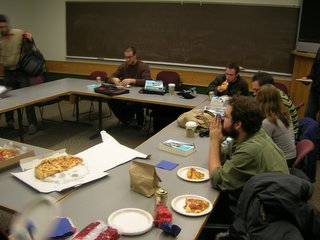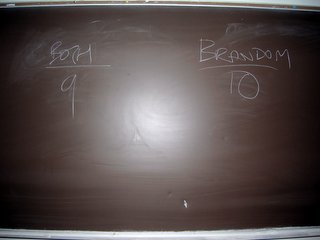Making It Explicit, Chapter One
Last night the workshop met to discuss chapter one of Brandom's Making it Explicit.

PART I
David F. opened the workshop with a story from his grad student days at Pitt. It involved Brandom stroking his beard and lecturing about his account of who we are in terms of saying 'we', and a Monty Python based pun.
David then suggested three broad ways of approaching intentionality that differ from Brandom's approach:
(1) Skepticism
(2) Naturalistic Reduction
(3) Naive acceptance (after suitable therapy, presumably)
In contrast, Brandom is going to offer an account of intentionality that reduces it to social norms of a certain kind.
After proposing these options, David asked: "Who is Brandom's account for?" Meaning, I think, "What philosophical anxieties is this meant to relieve?" or "What problem is this book supposed to solve?" That is where discussion began. There were several different proposals for how to answer David's question.
1. Jay E. said that he had asked John H. the same question about Making it Explicit in the preliminary essay workshop three years ago. John replied, "He was going for the brass ring". There was a pregnant pause in discussion while we waited for an explanation of what this meant. Jay said he thought John simply meant that Brandom thought that his account was true. I take it the upshot of Jay's comment was that saying true things is a perfectly legitimate goal for a philosophical project to have.
2. Nat H. said that the fact that the first chapter was set up in terms of the problem posed by Wittgenstein's rule-following argument and various failed (regularist) solutions to it indicated that he was looking for a genuine solution to the regress problem. The solution would be found in norms implicit in practice, rather than either in normless practices or hierarchies of explicit rules. Aiden G. raised an objection to this proposal (but I can't remember what it was).
3. Ben M. said that Brandom was looking for a solution to the regress problem but didn't consider the possibility that the regress shouldn't be allowed to begin. (In conversation with Ben before the workshop, we found p.45 n. 56, which suggests Brandom is aware that one way to respond to the problem of the regress of interpretations is to not let it get started. Brandom writes: "The division of explanatory strategies arises over the question of whether the practices invoked to halt the regress can be analyzed in terms of regularities and dispositions characterized without the use of normative vocabulary". The footnote, says: "Typically, though not in every case, by not letting [the regress] begin--since in the commonest cases we understand explicit claims, rules, principles, orders and so on without interpreting them".
4. Another workshop participant suggested that Brandom's project was to "render norms less mysterious" (p. xiv) or "render less mysterious" "the normative dimension of linguistic practice" (p. xiii). I take it that what is to be made less mysterious is the "fanciest sort of intentionality", that which is involved in propositional content (p. 7). David F. asked what was supposed to be so mysterious about this kind of intentionality. Brandom doesn't say anything (or report anyone as saying anything) that makes it sound particularly mysterious.
5. Jason B. suggested that maybe Brandom was engaged in a transcendental project--one of finding the necessary conditions for the possibility of thought (or "sapience") as such.
6. There were also suggestions that Brandom was engaged in a kind of "descriptive" metaphysical project, of showing the complex but interesting interconnections between concepts like "entitlement" and "acknowledgement". This seemed the least popular account of what he was up to.
PART II
Jason B., David F., Robert B. and Aiden G. argued about norms and the constitutive ideal of rationality. Robert B. said something about Davidson that made Aiden G. nearly jump out of his seat.
PART III
At the end of the workshop, we set about trying to determine what to do next: Quine or Brandom? Or both? We voted on whether to read the Quine or the Brandom, and Brandom won by a couple of votes. Then we voted on whether to read just the Brandom or read both the Quine and the Brandom, alternating from week to week. Reading just the Brandom won by a single vote. But there was some concern about this result, so Nat H. proposed that we vote again after reading chapter two of the Brandom in two weeks.



No comments:
Post a Comment